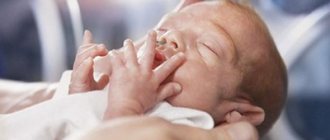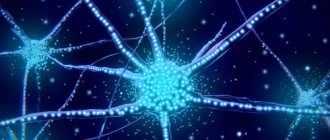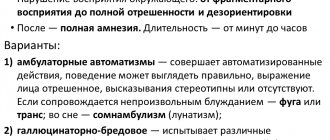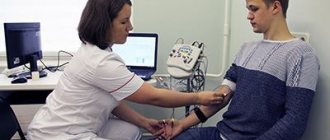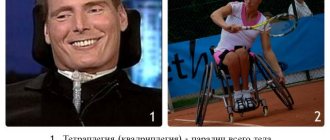What is PPCNS?
The very phrase perinatal period suggests that perinatal damage to the central nervous system develops in an unborn or newly born child. Perinatal damage to the central nervous system (PPCNS) is not one, but several diagnoses that imply dysfunction in the brain of a newborn child and can lead to persistent neurological consequences at an older age (for example, cerebral palsy, cerebral palsy).
The entire perinatal period is divided into three stages:
– from the 28th week until the moment of birth, the antenatal period ;
– the process of childbirth itself is called the intrapartum period ;
– the neonatal period is the period of time from the moment of birth to the 7th day of life inclusive.
In modern medicine there is no exact name for the disease when the central nervous system of the fetus is affected, there is only a collective one, it is called PPCNS or perinatal encephalopathy . Perinatal damage to the central nervous system in newborns is manifested by disturbances in the functioning of the musculoskeletal system, speech and mental disorders.
With the development of medicine, this diagnosis has ceased to be used for children older than one month. After a month, the doctor must make an accurate diagnosis of the child. It is during this period that the neurologist accurately determines how badly the nervous system is damaged. Prescribes treatment and ensures that it is chosen correctly.
What are the causes and risk factors for PPCNSL?
The reasons why perinatal damage to the central nervous system may develop are quite varied, among the most popular:
– somatic disease of the mother, which is accompanied by chronic intoxication;
– the presence of acute infectious diseases or chronic foci of infection while the expectant mother was carrying the child;
– if a woman’s nutritional process is disrupted, or she is not ripe for pregnancy and childbirth;
– disruption of uteroplacental blood flow during pregnancy;
– changes in metabolism also entail a disorder of the nervous system in the unborn child (increased bilirubin levels, neonatal jaundice);
– in case of severe toxicosis, both at an early stage and at a late stage, or the appearance of other problems with bearing a child;
– the environment is an important factor in the development of the disease;
– the appearance of pathology during childbirth - this may be weak labor, accelerated labor;
– if a child is born prematurely, then his body is not fully developed, therefore, against this background, a disturbance in the functioning of the central nervous system may appear;
– Children who have a hereditary factor are at greatest risk of developing central nervous system lesions.
All other causes of PPCNS are situational and, to a greater extent, their occurrence is simply impossible to predict. There are several ways of development of perinatal damage to the central nervous system in newborns, depending on the cause and subsequent symptoms, the analysis of which allows us to make an initial diagnosis:
– If a lack of oxygen is clearly detected while the baby is inside the mother’s body (hypoxia), then hypoxic damage to the central nervous system is diagnosed.
– During childbirth, the baby’s tissue structure may be damaged (this can be either the brain or the spinal cord). In this case, we are already talking about a traumatic lesion of the central nervous system, resulting in changes in the functioning of the brain.
– In case of metabolic disorders, metabolic and toxic-metabolic lesions may appear. This may be due to the use of alcohol, medications, or nicotine during pregnancy.
– Changes in the central nervous system in the presence of infectious diseases of the perinatal period.
Classification of perinatal lesions of the nervous system in newborns
Guidelines
Moscow, 1999
The classification project was discussed at the II Congress of the Russian Association of Perinatal Medicine Specialists. Moscow 1997
The methodological recommendations present fundamental approaches to the diagnosis of perinatal lesions of the nervous system, based on modern scientific advances and terminology used in the International Classification of Diseases and Related Health Problems, 10th revision (ICD 10).
The methodological recommendations are intended for pediatricians, neonatologists and neurologists of maternity hospitals, specialized hospitals for newborns and clinics.
The main developer is the Russian Association of Perinatal Medicine Specialists.
Leading experts took part in the preparation of the classification project
- Russian State Medical University
- Scientific Center for Obstetrics, Gynecology and Perinatology, Russian Academy of Medical Sciences
- Russian Medical Academy of Postgraduate Education
- Moscow Research Institute of Pediatrics and Pediatric Surgery
- Moscow Regional Research Institute of Obstetrics and Gynecology
- St. Petersburg State Pediatric Medical Academy
Core development team:
Ph.D. A.S. Burkova, Doctor of Medical Sciences N.N. Volodin, Ph.D. L.T. Zhurba, Doctor of Medical Sciences M.I. Medvedev, Ph.D. S.O. Rogatkin, Ph.D. O.V. Timonina.
The following people took part in the preparation of the classification project:
Doctor of Medical Sciences A.G. Antonov, Ph.D. E.N. Baibarina, Doctor of Medical Sciences Yu.I. Barashnev, Ph.D. A.M. Bolshakova, Ph.D. K.V. Vatolin, Ph.D. V.P. Geraskina, Ph.D. A.V. Gorbunov, Doctor of Medical Sciences G.M. Dementieva, Doctor of Medical Sciences M.S. Efimov, Doctor of Medical Sciences A.S. Petrukhin, Doctor of Medical Sciences G.M. Savelyeva, Doctor of Medical Sciences L.G. Sichinava, Academician of the Russian Academy of Medical Sciences, Doctor of Medical Sciences V.A. Tabolin, Doctor of Medical Sciences M.V. Fedorova, Doctor of Medical Sciences N.P. Shabalov.
Introduction
Deviations in the development of neuropsychic functions in young children in most cases have their roots in the perinatal period and are currently attracting increasing attention from researchers.
New opportunities have emerged in studying the origins of many diseases, pathological conditions and preventing irreversible consequences, often leading to severe childhood neurological disability.
In this regard, in the world literature of the last decade, “perinatal neurology” has emerged as an independent field of medicine, which reflects the achievements of specialists in various fields - obstetricians, neonatologists, pediatricians, neuropathologists, neurophysiologists, etc.
Modern methods for diagnosing the state of the nervous system of the fetus and newborn have been widely introduced into the clinical practice of obstetrics and neonatology: (neurosonography NSG, Doppler encephalography DEG, computed tomography CT, magnetic resonance imaging MRI, positron emission tomography PET, cerebral scintigraphy CSG, electroencephalography EEG, neuro-immunochemical identification of cerebral proteins, etc.).
The use of these advanced technologies in perinatal practice has made it possible to clarify the etiology, pathogenetic mechanisms, clinical and morphological structure, as well as the localization of cerebral disorders typical for different gestational ages, to develop unified approaches to terminology and to develop a new classification of perinatal damage to the nervous system of newborns.
This classification, in contrast to the previously used term “perinatal encephalopathy”, which reflects only the period of exposure to pathological factors and the general concept of brain dysfunction, provides for the division of neurological disorders of the neonatal period into 4 main groups depending on the leading mechanism of damage: I hypoxic, II traumatic , III toxic-metabolic and IV infectious.
In addition to the leading damaging factor, each of these groups distinguishes: nosological form, severity of damage and main neurological symptoms and syndromes.
Fundamentally new in the classification is the division of hypoxic brain damage into cerebral ischemia and intracranial hemorrhage.
In the heading “Intracranial birth injury”, in comparison with the previous classification, the number of nosological forms has been expanded: this block now includes subarachnoid and intraventricular hemorrhages.
The draft of this classification was compiled taking into account the terminological approaches used in ICD 10, which will make it possible to obtain the most reliable statistical data comparable to international standards, analyze the objective causes of morbidity and mortality, and develop effective methods for the treatment and prevention of early neurological disorders in children.
CLASSIFICATION OF PERINATAL NERVOUS SYSTEM LESIONS IN NEWBORNS
I. Hypoxic lesions of the central nervous system
| Pathogenetic characteristics | Nosological form | Main clinical symptoms and syndromes |
| I. A) P 91.0 Cerebral ischemia |
|
|
|
| |
|
| |
| I. B) P 52 Intracranial hemorrhages of hypoxic origin |
| No specific neurological symptoms |
|
| |
|
| |
|
| |
| The clinical picture depends on the location and volume of hemorrhage
| |
| I. B) Combined ischemic and hemorrhagic lesions of the central nervous system (non-traumatic) | The clinical picture and severity of the condition are determined by the leading type of lesion and localization |
II. Traumatic damage to the nervous system
| Pathogenetic characteristics | Nosological form | Main clinical symptoms and syndromes |
| II. A) P 10 Intracranial birth injury |
|
|
|
| |
|
| |
|
| |
|
| |
|
| |
| II. B) R 11.5 Birth injury of the spinal cord |
|
|
| II. B) R 14 Birth trauma of the peripheral nervous system |
Proximal Erb-Duchenne type (C 5-C 6) | Flaccid paresis of the proximal arm(s) |
| Flaccid paresis of the distal arm(s) Claude Bernard-Horner syndrome | |
| Flaccid total paresis of the arm(s) Claude Bernard-Horner syndrome Respiratory disorders rare | |
| Respiratory disorders (“paradoxical” breathing, tachypnea) Possibly asymptomatic | |
| On the losing side:
| |
|
III. Dysmetabolic and toxic-metabolic disorders of the central nervous system
| Pathogenetic characteristics | Nosological form | Main clinical symptoms and syndromes |
| III. A) P 70-P 71 Transient metabolic disorders |
|
|
|
| |
|
| |
|
| |
|
| |
|
| |
|
| |
| III. B) P 04 Toxic-metabolic disorders of the central nervous system |
|
|
IV. Damage to the central nervous system in infectious diseases of the perinatal period
| Pathogenetic characteristics | Nosological form | Main clinical symptoms and syndromes |
| IV. A) R 35 - R 37 Damage to the central nervous system due to intrauterine infections (TORCH syndrome) Encephalitis Meningitis Meningoencephalitis |
| |
| IV. B) CNS damage in neonatal sepsis Meningitis Meningoencephalitis Ventriculitis Encephalitis |
|
|
Comments
to the project “Classification of perinatal lesions of the nervous system in newborns”
In the first days of a child’s life, nosological diagnosis of lesions of the nervous system is often difficult due to the similarity of clinical neurological manifestations in various pathological conditions. Therefore, the classification shows the most common clinical symptom complexes characteristic of certain nosological forms.
In the first days of life, a syndromological diagnosis is allowed, but in the future it must be clarified. Obviously, the accuracy of the diagnosis increases as the newborn goes through various stages of nursing and depends on obtaining additional anamnestic data, clinical and laboratory tests.
The determining condition for accurate diagnosis is the accumulation, preservation and open exchange of standardized information received at various stages of medical care for newborn children.
The use of a syndromic approach when making a primary diagnosis allows neonatologists to more fully reflect the dynamics of the clinical picture in the absence of additional information and is justified in the conditions of obstetric institutions.
Examples of syndromic diagnosis: P 90 - newborn seizures (convulsive syndrome); P 91.3 - cerebral excitability of the newborn (hyperexcitability syndrome); P 91.4 - cerebral depression of the newborn (depression syndrome); P 91.5 - neonatal coma; P 91.8 - other specified disorders of the brain in a newborn (acquired hydrocephalus, intracranial hypertension, autonomic-visceral disorders); P 28.4 Other types of apnea in the newborn, etc.
The draft of this classification presents for the first time the differences in clinical neurological symptoms and syndromes, as well as the most typical types of cerebral damage in prematurely born and full-term children, which is due to the peculiarities of the blood supply to the brain in newborns of different gestational ages. The comments provide the most common clinical symptoms and syndromes depending on the degree of maturity.
The proposed classification contains ICD-10 indices corresponding to certain syndromes and nosological forms.
The basic principles for constructing a diagnosis of perinatal lesions of the nervous system in newborns should be based on a thorough analysis
- anamnestic information;
- clinical symptoms and syndromes;
- results of additional examinations
The logic of constructing a diagnosis for individual nosological forms is presented below.
Continued >>
What are the types of PPCNS syndromes?
PPCNSL is conventionally divided into several periods, depending on at what stage the disorder was identified and how it manifested itself.
– The acute period lasts from 7 to 10 days, it is extremely rare, but it can last up to a month.
– The period during which recovery occurs (recovery period) can last up to 6 months. If the child’s body recovers slowly, this period may take up to 2 years.
Pediatric neurologists distinguish the following types of perinatal lesions of the central nervous system, depending on the accompanying symptoms and syndrome:
– Violation of muscle tone . This syndrome is diagnosed according to deviations from the norm depending on the age of the infant. In the initial period of a child’s life, it is quite difficult to diagnose this syndrome, since in addition there is physiological hypertonicity (physiological stiffness of the newborn’s muscles).
– Nervous-reflex excitability syndrome is a syndrome associated with sleep disturbances, trembling of the chin, and the child flinching at any rustle or touch. This syndrome can be diagnosed only when somatic diseases of the newborn (for example, intestinal colic) are excluded. When examining such a child, the neurologist determines an increase in tendon reflexes, as well as an increase (revitalization) of the newborn’s automatisms (Moro reflex).
– Nervous system depression syndrome . This syndrome is the opposite in its characteristics to the previous one. It is diagnosed in children who are not active in the first months of their lives, they sleep a lot, they have decreased tone, they cannot hold their head up, and they have difficulty grasping their hands.
– An unfavorable prognosis for the child if intracranial hypertension syndrome . Its main signs are increased excitability and nervousness, while the fontanel begins to swell and thicken. Frequent regurgitation appears. Upon examination, the neurologist notices excessive growth of head circumference, possible divergence of the sutures of the skull, Graefe’s symptom (the “setting sun” symptom).
– One of the most dangerous and severe conditions in PPCNS is convulsive syndrome , which is one of the most serious manifestations of perinatal damage to the central nervous system.
In addition, any attentive mother can notice deviations in her child’s health much faster than a neurologist, if only because she monitors him around the clock and more than one day.
In any case, a baby living for the first year with any (even minimal, but not passing) deviations in health requires repeated consultations with specialists at the medical center, inclusion in the medical examination program (i.e. close observation by a neurologist and, if necessary, additional examination , such as ultrasound of the brain, electroencephalography, blood testing to determine the compensatory potential of the nervous system, etc.). Based on the findings received, the center’s specialists develop a development plan for such a child, select an individual scheme for preventive vaccinations, introduce complementary foods into the diet, and carry out therapeutic measures if necessary.
What are the symptoms and diagnostic criteria for PCNSL?
– Not every mother who does not have a medical education will be able to distinguish and determine at first glance that her child has a perinatal lesion of the central nervous system. But neurologists accurately determine the disease by the appearance of symptoms that are not characteristic of other disorders.
– when examining the baby, muscle hypertonicity or hypotonicity may be detected;
– the child is excessively restless, anxious and excited;
– the occurrence of trembling in the chin and limbs (tremor);
– the appearance of seizures;
– when examined with a hammer, a violation of the reflex sphere is noticeable;
– the appearance of unstable stools;
– heart rate changes; the appearance of irregularities on the child’s skin.
As a rule, after a year these symptoms disappear, but then appear with renewed vigor, so this situation simply cannot be neglected. One of the most dangerous manifestations and consequences of PPCNSL in the absence of a response to symptoms is the suspension of the development of the child’s psyche. The speech apparatus does not develop, and there is a delay in the development of motor skills . Also, one of the manifestations of the disease may be cerebrasthenic syndrome.
Perinatal lesions of the central nervous system
What are perinatal lesions of the central nervous system?
Perinatal lesions of the central nervous system (CNS) is a general term for suffering of the nervous system in newborn children caused by various causes.
How common are perinatal lesions of the central nervous system?
From 5 to 55% of children in the first year of life receive this diagnosis, since this number sometimes includes children with mild transient disorders of the nervous system. Severe forms of perinatal CNS lesions are observed in 1.5–10% of full-term and 60–70% of premature infants.
Why do perinatal lesions of the central nervous system occur?
The main cause of perinatal damage to the central nervous system in the fetus and newborn is hypoxia (oxygen deficiency), which occurs under the influence of various factors. Unfavorable conditions for the development of the fetus in the womb can be established long before pregnancy due to various diseases in a teenage girl, the expectant mother. Infectious and non-infectious diseases, hormonal disorders, bad habits, and occupational hazards during pregnancy cause increased hypoxia in the unborn child. Previous abortions lead to disruption of blood flow between mother and fetus and, consequently, to intrauterine hypoxia. Sexually transmitted infections (chlamydia, herpes, syphilis) play an important role in the development of perinatal lesions of the central nervous system. The cause of acute asphyxia during childbirth can be various disturbances in the normal course of labor, rapid or protracted labor, and incorrect position of the umbilical cord loops. Mechanical trauma to a child less often leads to perinatal damage to the central nervous system (especially the brain). The risk of child injury and acute asphyxia increases if childbirth takes place outside a medical facility, including water birth. In premature babies, due to their immaturity, perinatal damage to the central nervous system is observed more often.
Are perinatal lesions of the central nervous system dangerous?
Severe perinatal brain damage (including intracranial hemorrhage, severe cerebral ischemia) pose a real threat to the life and health of the child, even with timely, highly qualified medical care in a perinatal center. Moderate and mild forms of brain damage do not pose an immediate threat to life, but they can cause mental disorders and the development of motor activity in a child.
How do perinatal lesions of the central nervous system manifest themselves?
Features of disorders in perinatal damage to the central nervous system depend on the nature of the brain damage (hemorrhage in various brain structures, ischemia, infectious lesions), their severity, the degree of maturity of the child, and the stage of the disease.
For example, in premature infants with severe brain damage, general deep depression with respiratory failure, sometimes with short-term convulsions, predominates. In full-term newborns, both depression and increased excitability (motor restlessness, irritated cry), and prolonged convulsions are possible. By the end of the first month of a child’s life, lethargy and apathy can be replaced by increased excitability, muscle tone increases (muscles are too tense), and abnormal position of the limbs develops (clubfoot, etc.). In addition, it is possible to develop internal or external dropsy of the brain (hydrocephalus). The manifestations of spinal cord injury depend on the location and extent of the injury. For example, when the cervical spinal cord or nerve plexuses are damaged, “obstetric paralysis” occurs—sagging or immobility of the arm on the affected side.
With moderate brain damage, vegetative-visceral manifestations may predominate: persistent regurgitation, delayed or frequent bowel movements, bloating, thermoregulation disorders (the body's reaction to heat and cold), pallor and marbling of the skin, lability of the cardiovascular and respiratory systems, etc.
In children with severe perinatal damage to the central nervous system, from the end of the first month of life, a delay in the development of the psyche and movements is noted: the reaction to communication is sluggish, a monotonous cry (not emotionally colored). Possible early (at 3–4 months) formation of persistent motor disorders similar to cerebral palsy.
It should be noted that moderate (and sometimes severe) lesions of the central nervous system can be asymptomatic and appear at 2–3 months of life. Parents should be alerted to insufficient physical activity or its excess, attacks of causeless restlessness, lack of a clear reaction to sounds and visual stimuli in a full-term baby older than 2 weeks, as well as a stable (habitual) position of the body with a turn to one side, crossing the legs in a vertical position, support “on tiptoes”, persistent throwing back of the head, bulging or pulsating fontanel, separation of cranial sutures, habitual squinting or rolling of the eyes (the “setting sun” symptom).
How is perinatal damage to the central nervous system diagnosed?
The diagnosis is based on medical examination data, anamnestic data and is confirmed by instrumental studies. Ultrasound examination (ultrasound) of the brain with assessment of the condition of its blood vessels (Dopplerography) is of great importance. If necessary, use X-ray examination of the skull, spine, computed tomography (CT), magnetic resonance imaging (MRI).
What methods of treatment and prevention of perinatal damage to the central nervous system exist?
In the acute period of severe perinatal brain damage, treatment is carried out in the neonatal intensive care unit. First of all, disturbances in the functioning of the respiratory, cardiovascular system and metabolic disorders are eliminated, seizures are eliminated (if necessary, artificial ventilation of the lungs, intravenous infusions, and parenteral nutrition are performed). Next, the newborns are transferred to a special department, where individual treatment is continued depending on the nature and severity of the brain damage: anticonvulsants are used, in case of developing hydrocephalus - dehydration drugs, as well as drugs that stimulate the growth of capillaries and improve the nutrition of damaged brain tissue. These same drugs, as prescribed by a neurologist, can be used throughout the first year of life in repeated courses. For moderate and especially mild lesions of the central nervous system, non-drug therapy is mainly used.
In the recovery period (from the end of the first year of life), non-drug rehabilitation methods are of decisive importance: therapeutic massage and gymnastics, exercises in water, physiotherapy, pedagogical methods of music therapy (healing and treating the body with the help of music).
Prevention of perinatal brain damage can be primary and secondary
Primary prevention involves improving the health of adolescents (future parents), routine monitoring of pregnant women in order to identify pregnancy disorders as early as possible, and competent obstetric care (including planned caesarean section if there is a high risk of birth trauma).
Secondary prevention is the prevention of adverse consequences of perinatal pathology for the child, carrying out comprehensive treatment and effectively restoring his health.
Head of the neuro-orthopedic department of the TANAR Family Clinic Gulfiya Tyafikovna Usmanova
How is PCNSL treated?
To restore the basic functions of the central nervous system, as well as to reduce the manifestation of neurological symptoms, the baby is prescribed a whole range of medications. Treatment can include, for example, nootropic drugs that can restore trophic processes in the brain - piracetam, Cerebrolysin, Cortexin, pantocalcin, solcoseryl and many others. In order to stimulate general reactivity, a newborn child is given a course of therapeutic massage, special gymnastics, and, if necessary, a set of physiotherapeutic procedures (for example, electrophoresis and microcurrents).
If parents detect at least one of the signs of central nervous system damage, they should immediately consult a doctor. Do not forget that the development of each child is an individual process. Such individual characteristics of a newborn child in each specific case play an important role in the process of restoring the functions of higher nervous activity.
What are the dangers and consequences of PPCNS?
There is an opinion among experts that if the central nervous system of the fetus has been damaged, it cannot be completely restored. But practicing neurologists say the opposite. They say that if the disease is treated correctly and in a timely manner, it is possible to achieve partial or complete restoration of the functions of the nervous system. But even despite such an optimistic forecast, if you look at all possible diseases of a child associated with the nervous system, then 50% of their total number leads to disability, while about 80% of it is allocated to perinatal damage to the central nervous system.
